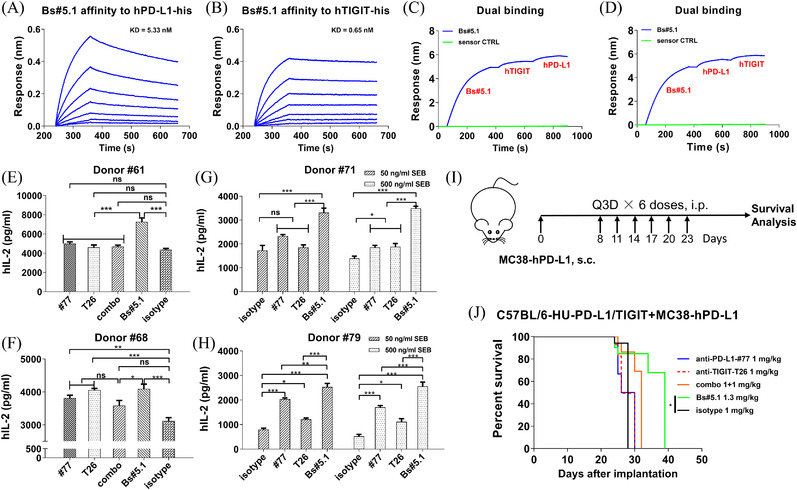FIGURE 3.

Characterization of BsAb candidates in vitro and in vivo. (A,B) Binding kinetics of Bs#5.1 to hPD‐L1‐his and hTIGIT‐his as determined by BLI using the protein A sensor. (C,D) Dual binding capacity of BsAb on Octet. (E,F,G,H) Bs#5.1 greatly enhanced human IL‐2 production in SEB‐stimulated PBMC assay. Human PBMCs were pre‐incubated with 133.3 nM antibodies at 37°C for 30 min and then stimulated with 1 μg/ml of SEB (E and F) or 50 and 500 ng/ml of SEB (G and H) in 5% CO2 incubator for 3 days. Human IL‐2 release in the supernatants was detected by ELISA. Representative graphs were performed in triplicate and data were expressed as mean ± SEM. P‐values were determined using one‐way ANOVA with Tukey's multiple comparison test. (I,J) In vivo antitumor activity of Bs#5.1 in MC38‐hPD‐L1‐engrafted C57BL/6‐HU‐PD‐L1/TIGIT transgenic mouse model. (I) Diagram of BsAb animal study. (J) Survival analysis of MC38‐hPD‐L1 tumour‐bearing mice. C57BL/6‐HU‐PD‐L1/TIGIT mice were inoculated with 5 × 105 MC38‐hPD‐L1 tumour cells. Antibodies were administered every 3 days, and tumour volumes were monitored by an electric calliper every other day. Survival analysis was conducted using GraphPad software. n = 5 mice per group. (ns, not significant p > .05, *p < .05, **p < .01, ***p < .001)
